Numerical Investigation on the Jet Characteristics and Combustion Process of an Active Prechamber Combustion System Fueled with Natural Gas
Abstract
:1. Introduction
2. Numerical Method
2.1. Numerical Model
2.2. Modeling Validation
2.3. Definition of Jet Characteristics
3. Results and Discussion
3.1. Effect of Spark Timing on Jet Characteristics
3.2. Effect of the Prechamber Global Equivalence Ratio on Jet Characteristics
3.3. Effect of the Jet Characteristics on Ignition and Combustion in the Main Chamber
4. Conclusions
- (1)
- The sparking timing has a great impact on the jet velocity and chemical characteristics, while it has little impact on the thermal characteristics and penetration distance. With the earlier spark timing, the jet velocity is higher, and the jet contains more reactive chemical components, such as OH and CH2O radicals.
- (2)
- The prechamber global equivalence ratio has a great impact on the jet velocity, temperature, and chemical characteristics, while it has almost no impact on the penetration distance. With the increase of the prechamber global equivalence ratio, the velocity of the jet increases firstly and then decreases, the temperature drops, and the OH and CH2O free radicals are reduced, but the combustion intermediates, CO and H2, increase.
- (3)
- Two different ignition mechanisms can be identified in the main chamber, i.e., flame ignition (ignition by flame and reactive free radicals) and jet ignition (ignition by hot combustion intermediates). As the prechamber global equivalence ratio increases, the ignition mechanism changes from flame ignition to jet ignition, and the ignition delay is shortened, but the combustion duration is extended, mainly due to an increase in hot combustion intermediates, CO and H2, downstream of the jet.
- (4)
- The differences in the jet characteristics caused by spark timings have a limited effect on the ignition mechanism in the main chamber. Furthermore, the ignition mechanisms for different spark timings are all flame ignition. However, a higher jet velocity and more reactive intermediate species are beneficial to reduce the ignition delay and combustion duration with an earlier spark timing.
Author Contributions
Funding
Institutional Review Board Statement
Informed Consent Statement
Conflicts of Interest
References
- Reynolds, C.; Evans, R.; Andreassi, L.; Cordiner, S.; Mulone, V. The Effect of Varying the Injected Charge Stoichiometry in a Partially Stratified Charge Natural Gas Engine. In SAE Technical Paper; 2005-01-0247; SAE International: Warrendale, PA, USA, 2005. [Google Scholar]
- Sasaki, H.; Sekiyama, S.; Nakashima, K. A new combustion system of a heat-insulated natural gas engine with a prechamber having a throat valve. Int. J. Engine Res. 2002, 3, 197–208. [Google Scholar] [CrossRef]
- Alvarez, C.E.C.; Couto, G.E.; Roso, V.R.; Thiriet, A.B.; Valle, R.M. A review of prechamber ignition systems as lean combustion technology for si engines. Appl. Therm. Eng. 2018, 128, 107–120. [Google Scholar] [CrossRef]
- Attard, W.P.; Fraser, N.; Parsons, P.; Toulson, E. A Turbulent Jet Ignition Pre-Chamber Combustion System for Large Fuel Economy Improvements in a Modern Vehicle Powertrain. SAE Int. J. Engines 2010, 3, 20–37. [Google Scholar] [CrossRef] [Green Version]
- Bunce, M.; Blaxill, H.; Kulatilaka, W.; Jiang, N. The Effects of Turbulent Jet Characteristics on Engine Performance Using a Pre-Chamber Combustor. In SAE Technical Paper; 2014-01-1195; SAE International: Warrendale, PA, USA, 2014. [Google Scholar]
- Olsen, D.B.; Lisowski, J.M. Prechamber NOx formation in low BMEP 2-stroke cycle natural gas engines. Appl. Therm. Eng. 2009, 29, 687–694. [Google Scholar] [CrossRef]
- Attard, W.P.; Blaxill, H.; Anderson, E.K.; Litke, P. Knock Limit Extension with a Gasoline Fueled Pre-Chamber Jet Igniter in a Modern Vehicle Powertrain. SAE Int. J. Engines 2012, 5, 1201–1215. [Google Scholar] [CrossRef]
- Bunce, M.; Blaxill, H. Sub-200 g/kWh BSFC on a Light Duty Gasoline Engine. In SAE Technical Paper; 2016-01-0709; SAE International: Warrendale, PA, USA, 2016. [Google Scholar]
- Peters, N.; Subramanyam SK, P.; Bunce, M.; Blaxill, H.; Cooper, A. Optimization of Lambda across the Engine Map for the Purpose of Maximizing Thermal Efficiency of a Jet Ignition Engine. SAE Int. J. Engines 2020, 2, 3140–3150. [Google Scholar]
- Benajes, J.; Novella, R.; Gomez-Soriano, J.; Martinez-Hernandiz, P.J.; Libert, C.; Dabiri, M. Evaluation of the passive pre-chamber ignition concept for future high compression ratio turbocharged spark-ignition engines. Appl. Energy 2019, 248, 576–588. [Google Scholar] [CrossRef]
- Jamrozik, A.; Tutak, W. Theoretical analysis of air-fuel mixture formation in the combustion chambers of the gas engine with two-stage combustion system. Bull. Pol. Acad. Sci. Tech. Sci. 2014, 62, 779–790. [Google Scholar] [CrossRef] [Green Version]
- Jamrozik, A.; Tutak, W.; Kociszewski, A.; Sosnowski, M. Numerical simulation of two-stage combustion in SI engine with prechamber. Appl. Math. Model. 2013, 37, 2961–2982. [Google Scholar] [CrossRef]
- Szwaja, S.; Jamrozik, A.; Tutak, W. A two-stage combustion system for burning lean gasoline mixtures in a stationary spark ignited engine. Appl. Energy 2013, 105, 271–281. [Google Scholar] [CrossRef]
- Shah, A.; Tunestal, P.; Johansson, B. Effect of Pre-Chamber Volume and Nozzle Diameter on Pre-Chamber Ignition in Heavy Duty Natural Gas Engines. In SAE Technical Paper; 2015-01-0867; SAE International: Warrendale, PA, USA, 2015. [Google Scholar]
- Bigalli, S.; Catalani, I.; Balduzzi, F.; Matteazzi, N.; Agostinelli, L.; De Luca, M.; Ferrara, G. Numerical Investigation on the Perfor-mance of a 4-Stroke Engine with Different Passive Pre-Chamber Geometries Using a Detailed Chemistry Solver. Energies 2022, 15, 4968. [Google Scholar] [CrossRef]
- Gentz, G.; Thelen, B.; Gholamisheeri, M.; Litke, P.; Brown, A.; Hoke, J.; Toulson, E. A study of the influence of orifice diameter on a turbulent jet ignition system through combustion visualization and performance characterization in a rapid compression machine. Appl. Therm. Eng. 2015, 81, 399–411. [Google Scholar] [CrossRef]
- Thelen, B.; Toulson, E. A Computational Study of the Effects of Spark Location on the Performance of a Turbulent Jet Ignition System. In SAE Technical Paper; SAE International: Warrendale, PA, USA, 2016-01-0608; 2016. [Google Scholar]
- Wang, N.; Liu, J.; Chang, W.; Lee, C.-F. The Effect of In-Cylinder Temperature on the Ignition Initiation Location of a Pre-Chamber Generated Hot Turbulent Jet. In SAE Technical Paper; 2018-01-0184; SAE International: Warrendale, PA, USA, 2018. [Google Scholar]
- Ju, D.; Huang, Z.; Li, X.; Zhang, T.; Gai, W. Comparison of open chamber and pre-chamber ignition of methane/air mixtures in a large bore constant volume chamber: Effect of excess air ratio and pre-mixed pressure. Appl. Energy 2020, 260, 114319. [Google Scholar] [CrossRef]
- Onofrio, G.; Napolitano, P.; Abagnale, C.; Guido, C.; Beatrice, C. Model Development of a CNG Active Pre-chamber Fuel Injection System. In SAE Technical Paper; 2021-24-0090; SAE International: Warrendale, PA, USA, 2021. [Google Scholar]
- Zheng, Z.Y.; Wang, L.; Pan, J.Y.; Pan, M.Z.; Wei, H.Q. Numerical investigations on turbulent jet ignition with gasoline as an auxiliary fuel in rapid compression machines. Combust. Sci. Technol. 2021, 1–20. [Google Scholar] [CrossRef]
- Bunce, M.; Blaxill, H. Methodology for Combustion Analysis of a Spark Ignition Engine Incorporating a Pre-Chamber Combustor. In SAE Technical Paper; 2014-01-2603; SAE International: Warrendale, PA, USA, 2014. [Google Scholar]
- Benekos, S.; Frouzakis, C.E.; Giannakopoulos, G.K.; Bolla, M.; Wright, Y.M.; Boulouchos, K. Prechamber ignition: An exploratory 2-D DNS study of the effects of initial temperature and main chamber composition. Combust. Flame 2020, 215, 10–27. [Google Scholar] [CrossRef]
- Benekos, S.; Frouzakis, C.E.; Giannakopoulos, G.K.; Altantzis, C.; Boulouchos, K. A 2-D DNS study of the effects of nozzle geometry, ignition kernel placement and initial turbulence on prechamber ignition. Combust. Flame 2021, 225, 272–290. [Google Scholar] [CrossRef]
- Allison, P.M.; de Oliveira, M.; Giusti, A.; Mastorakos, E. Pre-chamber ignition mechanism: Experiments and simulations on turbulent jet flame structure. Fuel 2018, 230, 274–281. [Google Scholar] [CrossRef] [Green Version]
- Toulson, E.; Watson, H.C.; Attard, W.P. Modeling of Alterative Prechamber Fuels in Jet Assisted Ignition of Gasoline and LPG. In SAE Technical Paper; 2009-01-0721; SAE International: Warrendale, PA, USA, 2009. [Google Scholar]
- Qin, F.; Shah, A.; Huang, Z.; Peng, L.; Tunestal, P. Detailed numerical simulation of transient mixing and combustion of premixed methane/air mixtures in a pre-chamber/main-chamber system relevant to internal combustion engines. Combust. Flame 2018, 188, 357–366. [Google Scholar] [CrossRef]
- Pan, J.; He, Y.; Li, T.; Wei, H.; Wang, L.; Shu, G. Effect of Temperature Conditions on Flame Evolutions of Turbulent Jet Ignition. Energies 2021, 14, 2226. [Google Scholar] [CrossRef]
- Biswas, S.; Tanvir, S.; Wang, H.; Qiao, L. On ignition mechanisms of premixed CH4/air and H2/air using a hot turbulent jet generated by pre-chamber combustion. Appl. Therm. Eng. 2016, 106, 925–937. [Google Scholar] [CrossRef]
- Richards, K.J.; Senecal, P.K.; Pomraning, E. CONVERGE Manual (Version 2.3); Convergent Science Inc.: Madison, WI, USA, 2016. [Google Scholar]
- Huang, J.; Hill, P.G.; Bushe, W.K.; Munshi, S.R. Shock-tube study of methane ignition under engine-relevant conditions: Experiments and modeling. Combust. Flame 2004, 136, 25–42. [Google Scholar] [CrossRef]
- Muller, M.; Freeman, C.; Zhao, P.; Ge, H. Numerical Simulation of Ignition Mechanism in the Main Chamber of Turbulent Jet Ignition System. In Proceedings of the ASME 2018 Internal Combustion Engine Division Fall Technical Conference, San Diego, CA, USA, 4–7 November 2018. [Google Scholar]
- Ewald, J.; Peters, N. A level set based flamelet model for the prediction of combustion in spark ignition engines. In Proceedings of the 15th International Multidimensional Engine Modeling User’s Group Meeting, Detroit, MI, USA, 20 April 2005. [Google Scholar]
- O’Rourke, P.J.; Amsden, A.A. The TAB Method for Numerical Calculation of Spray Droplet Breakup; Los Alamos National Lab: Los Alamos, NM, USA, 1987. [Google Scholar]
- Liu, L.; Wu, Y.; Xiong, Q.; Liu, T. Analysis on flow motion and combustion process in pre-chamber and main chamber for low-speed two-stroke dual-fuel engine. In SAE Technical Paper; 2019-01-2175; SAE International: Warrendale, PA, USA, 2019. [Google Scholar]



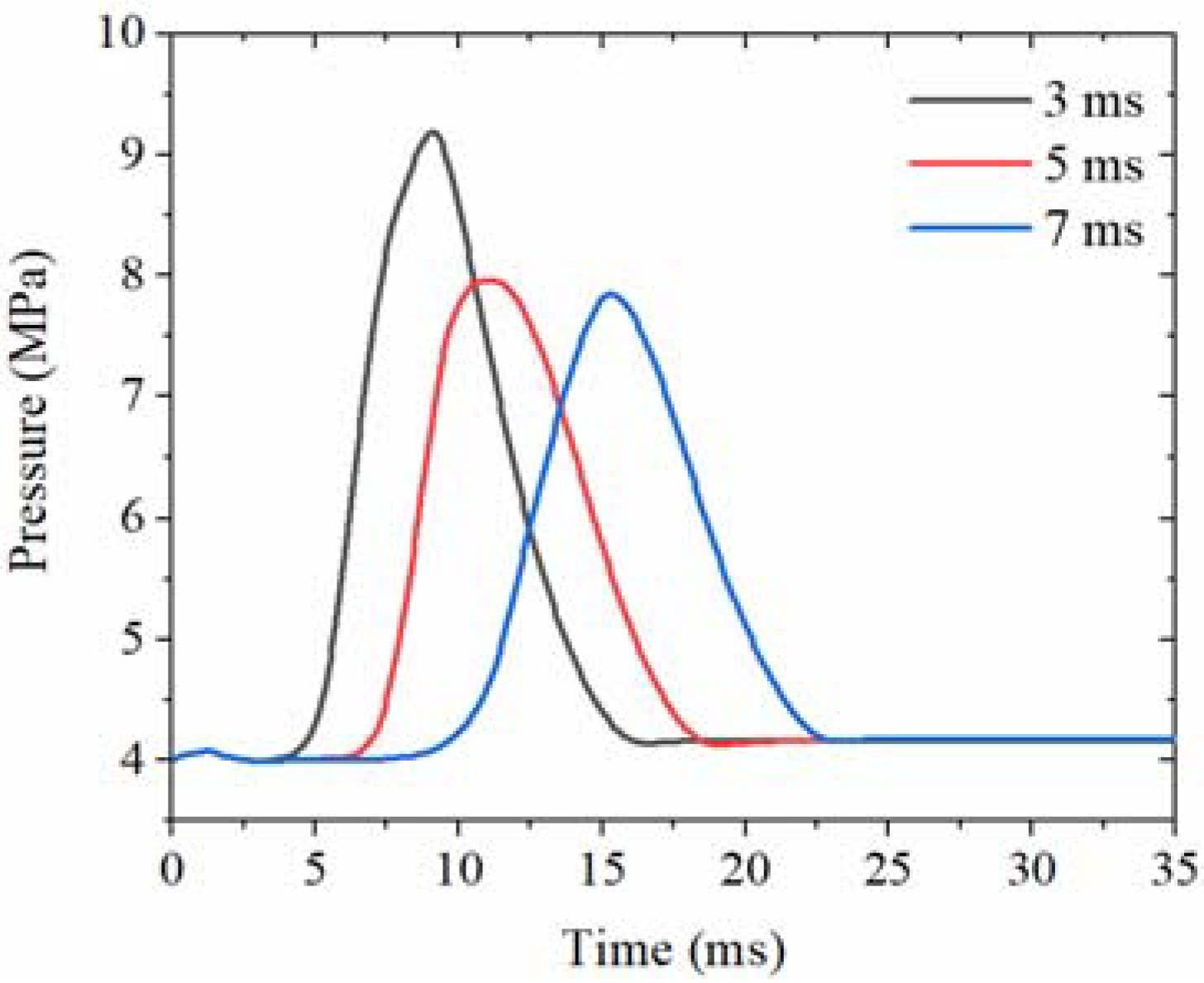
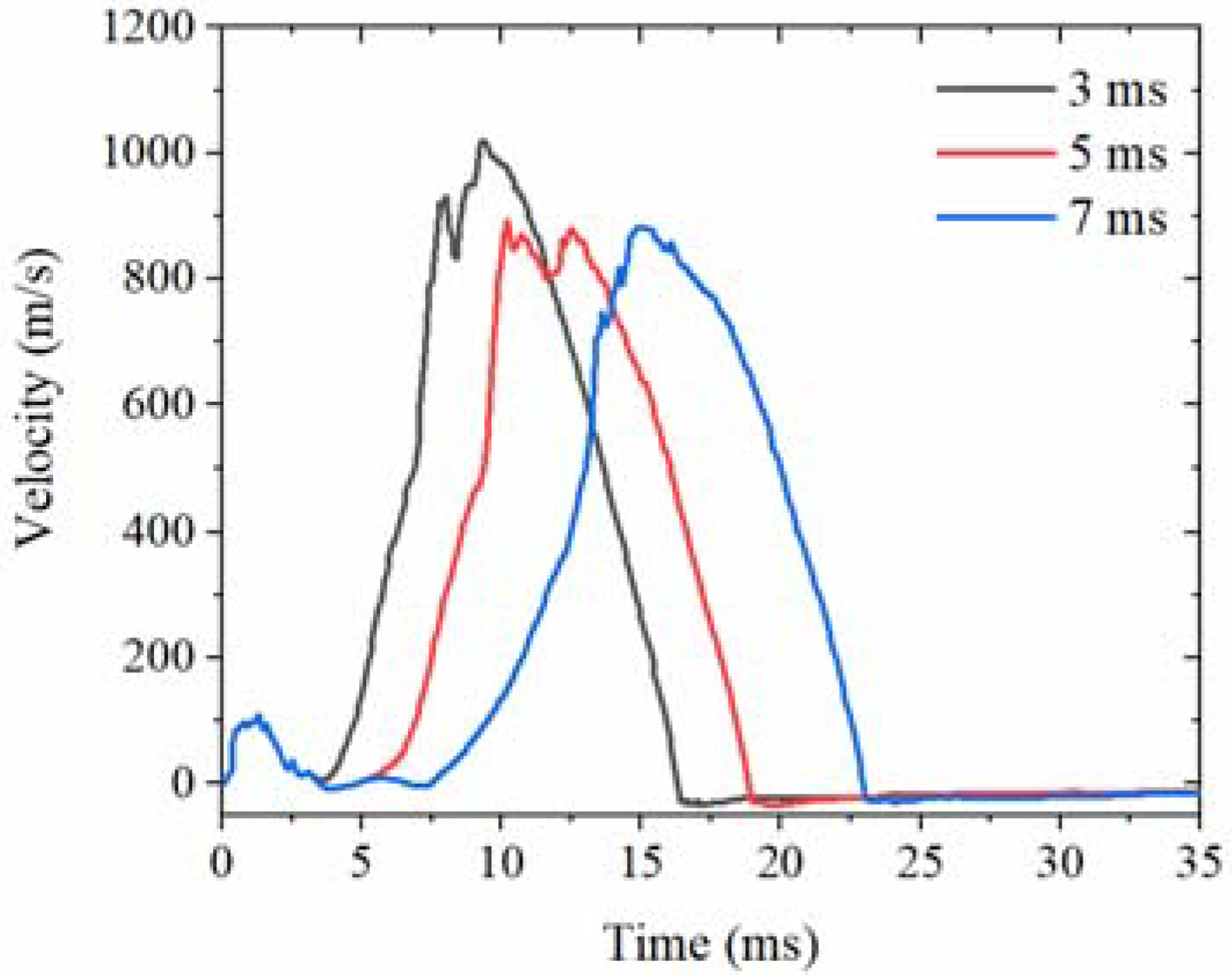


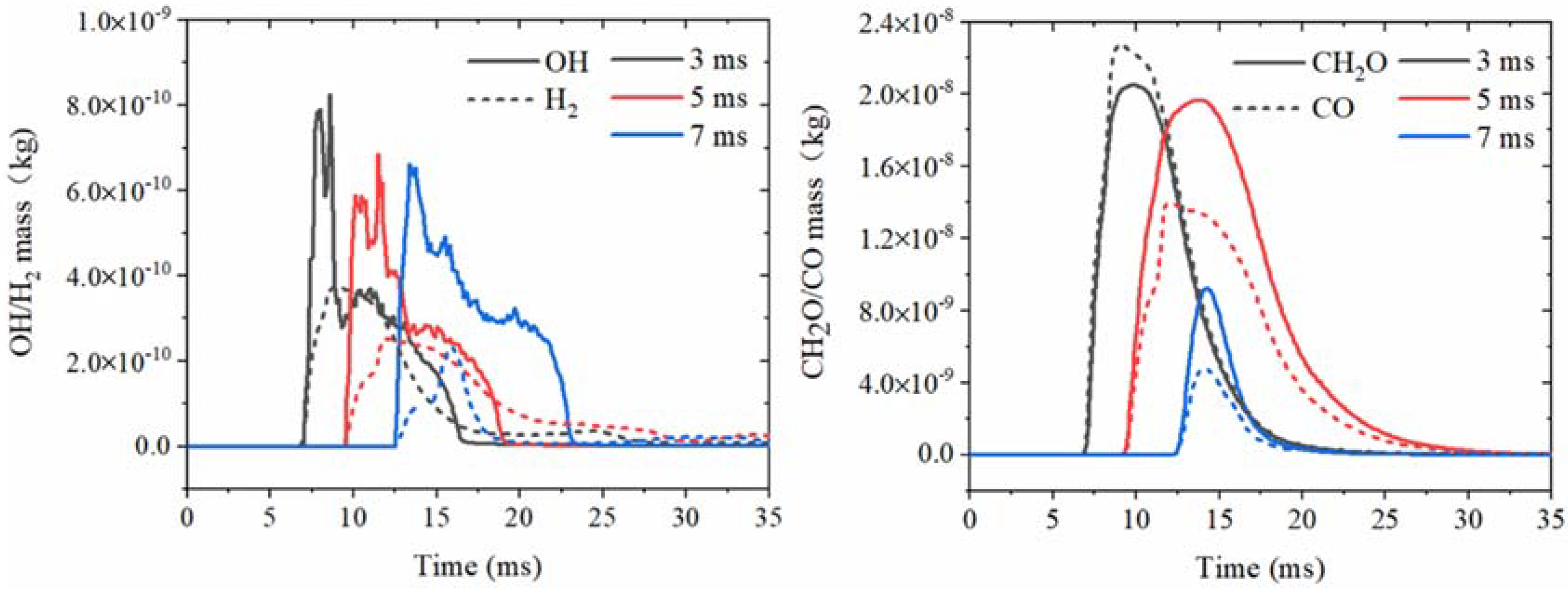
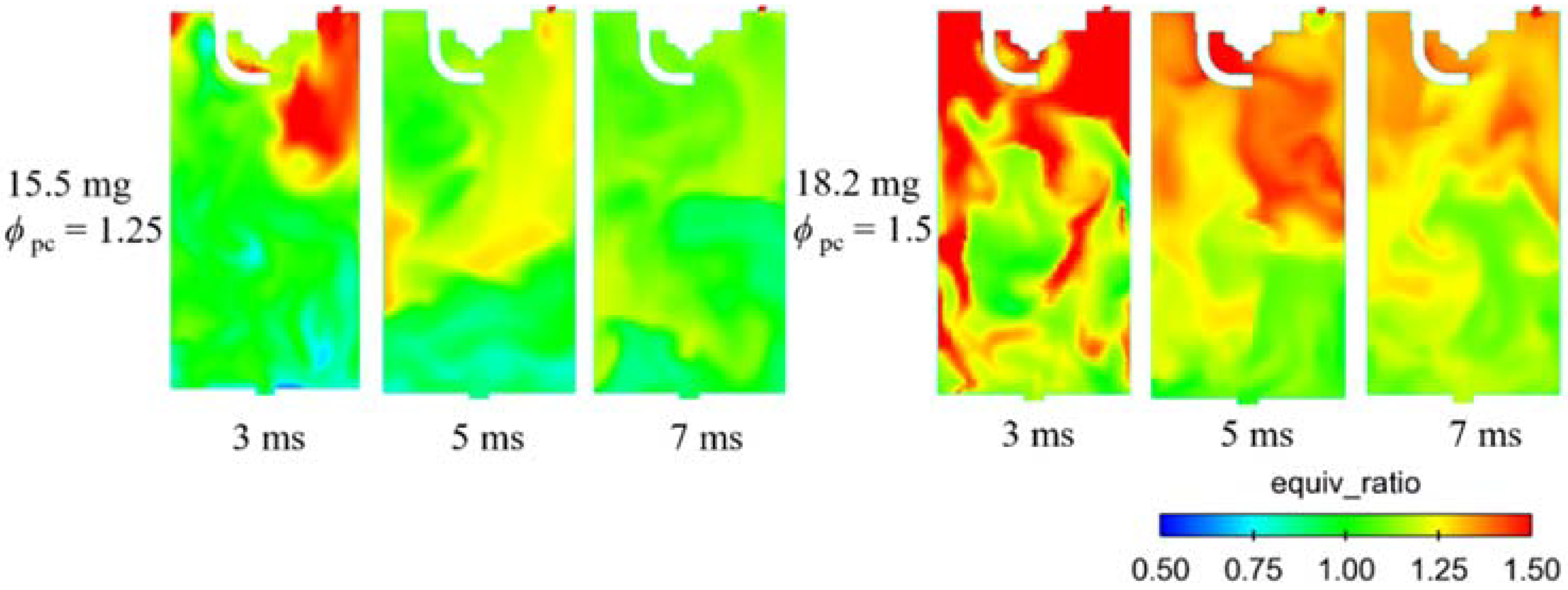

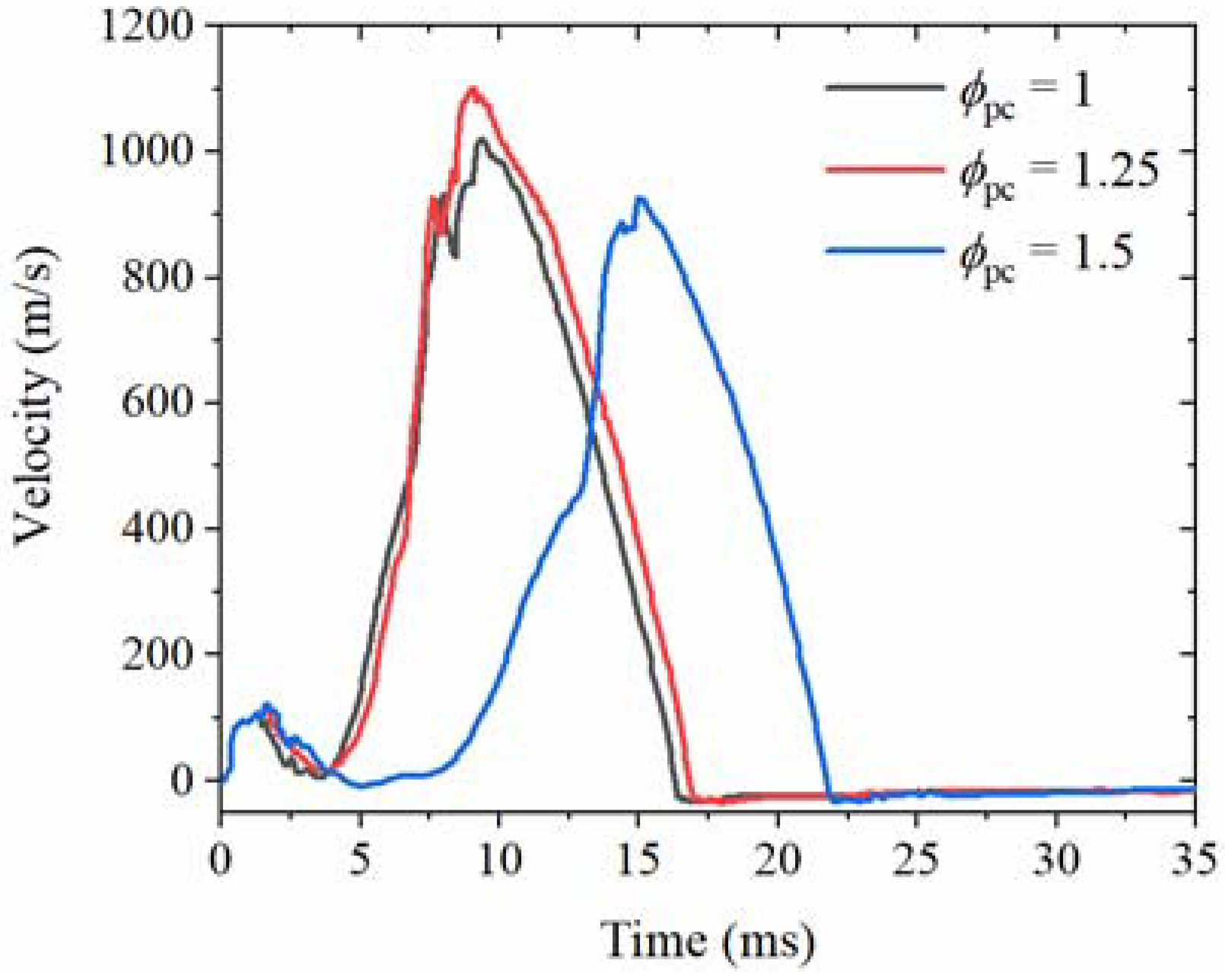



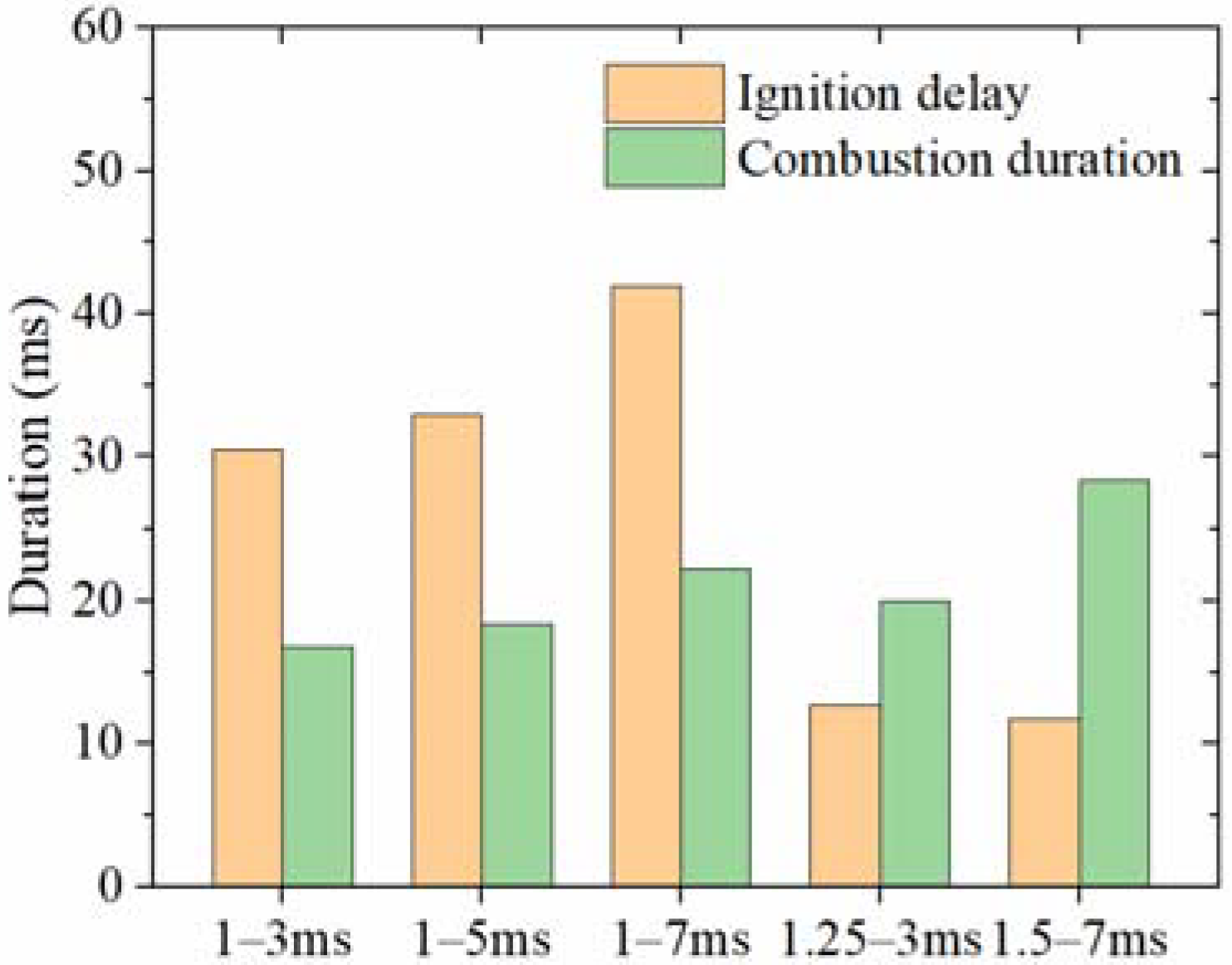
| Model Type | Model Name |
|---|---|
| Turbulence model | Large Eddy Simulation [32] |
| Combustion model | G-equation coupled with the chemical reaction mechanism [33] |
| Heat transfer model | O’Rourke and Amsden [34] |
| Spark model | Spherical energy source |
| Parameters | Case 1 | Case 2 |
|---|---|---|
| Fuel | CH4 | CH4 |
| Test number in the literature [29] | 1 | 20 |
| Prechamber volume | 100 mL | 100 mL |
| Main chamber volume | 10 L | 10 L |
| Nozzle diameter | 4.5 mm | 4.5 mm |
| Initial temperature | 500 K | 500 K |
| Initial pressure | 0.1 MPa | 0.4 MPa |
| Prechamber equivalence ratio | 1.0 | 1.0 |
| Main chamber equivalence ratio | 0.8 | 0.9 |
| Jet Characteristics | Definition |
|---|---|
| Mixing characteristics | The velocity of jet center at nozzle exit |
| Penetration distance | |
| Thermal characteristic | Jet temperature |
| Chemical characteristics | OH mass and distribution |
| CH2O mass and distribution | |
| CO mass and distribution | |
| H2 mass and distribution |
| Parameters | Value | ||
|---|---|---|---|
| Injection pressure | 22 MPa | ||
| Injection temperature | 370 K | ||
| Injection mass | 12.7 mg | ||
| Injection timing | 0 ms | ||
| Injection duration | 1.38 ms | ||
| Prechamber global equivalence ratio (ϕpc) | 1 | ||
| Spark timing | 3 ms | 5 ms | 7 ms |
| Parameters | Value | ||
|---|---|---|---|
| Injection pressure | 22 MPa | ||
| Injection temperature | 370 K | ||
| Injection mass | 12.7 mg | 15.5 mg | 18.2 mg |
| Injection timing | 0 ms | ||
| Injection duration | 1.38 ms | 1.67 ms | 1.94 ms |
| Prechamber global equivalence ratio (ϕpc) | 1 | 1.25 | 1.5 |
| Spark timing | 3 ms | 3 ms | 7 ms |
Publisher’s Note: MDPI stays neutral with regard to jurisdictional claims in published maps and institutional affiliations. |
© 2022 by the authors. Licensee MDPI, Basel, Switzerland. This article is an open access article distributed under the terms and conditions of the Creative Commons Attribution (CC BY) license (https://creativecommons.org/licenses/by/4.0/).
Share and Cite
Xu, L.; Li, G.; Yao, M.; Zheng, Z.; Wang, H. Numerical Investigation on the Jet Characteristics and Combustion Process of an Active Prechamber Combustion System Fueled with Natural Gas. Energies 2022, 15, 5356. https://doi.org/10.3390/en15155356
Xu L, Li G, Yao M, Zheng Z, Wang H. Numerical Investigation on the Jet Characteristics and Combustion Process of an Active Prechamber Combustion System Fueled with Natural Gas. Energies. 2022; 15(15):5356. https://doi.org/10.3390/en15155356
Chicago/Turabian StyleXu, Lina, Gang Li, Mingfa Yao, Zunqing Zheng, and Hu Wang. 2022. "Numerical Investigation on the Jet Characteristics and Combustion Process of an Active Prechamber Combustion System Fueled with Natural Gas" Energies 15, no. 15: 5356. https://doi.org/10.3390/en15155356
APA StyleXu, L., Li, G., Yao, M., Zheng, Z., & Wang, H. (2022). Numerical Investigation on the Jet Characteristics and Combustion Process of an Active Prechamber Combustion System Fueled with Natural Gas. Energies, 15(15), 5356. https://doi.org/10.3390/en15155356






